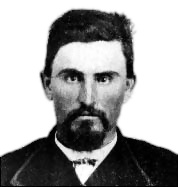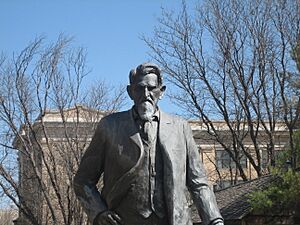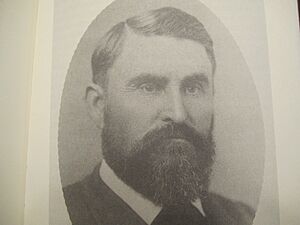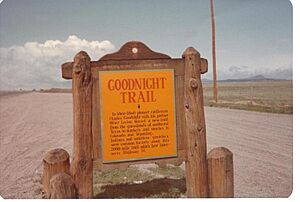Charles Goodnight facts for kids
Quick facts for kids
Charles Goodnight
|
|
|---|---|

Goodnight in 1860
|
|
| Born | March 5, 1836 |
| Died | December 12, 1929 (aged 93) Phoenix, Arizona, US
|
| Resting place | Goodnight Cemetery near Amarillo, Texas |
| Occupation | Rancher |
| Spouse(s) | (1) Mary Ann Dyer Goodnight (married 1870–1926, her death) (2) Corinne Goodnight Goodnight (married 1927–1929, his death) (2) Clarendon, Texas |
Charles Goodnight (born March 5, 1836 – died December 12, 1929) was a famous American cattle rancher. He worked in the American West and is known as one of the most important ranchers in Texas. People sometimes call him the "father of the Texas Panhandle." A famous historian named J. Frank Dobie said Goodnight was one of the greatest "cowmen" in history. In 1955, he was honored in the Hall of Great Westerners at the National Cowboy & Western Heritage Museum.
Early Life of Charles Goodnight
Goodnight was born in Macoupin County, Illinois, which is northeast of St. Louis. He was the fourth child of Charles and Charlotte Goodnight. In 1846, when he was ten, Goodnight moved to Texas with his mother and stepfather.
When he was 20, in 1856, he became a cowboy. He also joined the local group of fighters, called a militia. They fought against Comanche raiders. A year later, in 1857, Goodnight joined the Texas Rangers. He helped lead a group that found a Comanche camp in 1860. This led to the return of Cynthia Ann Parker, who had been living with the Comanche. Later, Goodnight made an agreement with her son, Quanah Parker.
When the Civil War started, Goodnight joined the army. He spent most of his time guarding the frontier from Native American raids. Goodnight believed a good scout needed to be a "natural woodsman." He said they should rarely need a compass.
Cattle Ranching and Trails

After the Civil War, Goodnight started moving wild Texas Longhorn cattle north. He moved them from West Texas to places where they could be loaded onto trains. This was called "making the gather." It was a huge effort to round up cattle that had roamed freely during the war.
In 1866, Goodnight and Oliver Loving started their first cattle drive. This route became known as the Goodnight-Loving Trail. They gathered their cattle near the Brazos River. Then they went southwest, crossed the Pecos River, and followed it north into New Mexico. They sold their cattle to the Army at Fort Sumner. This long route helped them avoid the Comanche lands. Later, they extended the trail further north into Colorado and Wyoming.
Goodnight also invented the chuckwagon. This special wagon carried food and supplies for cowboys on long cattle drives. It was first used on his very first drive. After Loving's death, Goodnight partnered with John Chisum to supply cattle to the United States Army.
Goodnight and Loving were very good friends. Goodnight stayed with Loving for two weeks as he was dying. He carried Loving's body all the way from New Mexico to Weatherford for burial.
In 1876, Goodnight started the first ranch in the Texas Panhandle. It was called the JA Ranch and was located in the Palo Duro Canyon. He partnered with an Irish businessman, John George Adair, to create the ranch. The "JA" in the name stands for "John Adair." In 1880, Goodnight helped start the Panhandle Stockman's Association. This group worked to improve cattle breeding. It also helped reduce problems with cattle thieves, called rustlers, and outlaws. After Adair died, Goodnight worked with Adair's wife, Cornelia Adair.
Bison Preservation
In 1876, the Goodnights also started to save a herd of native plains American bison. This herd is believed to still exist today at Caprock Canyons State Park and Trailway. Bison from this herd were later sent to Yellowstone National Park in 1902. They also went to large zoos and ranches across the country.
Goodnight also tried to crossbreed bison with regular cattle. He called these new animals "cattalo," which are also known as Beefalo.
Charles Goodnight's Personal Life
On July 26, 1870, Charles Goodnight married Mary Ann "Molly" Dyer. She was a teacher from Weatherford, Texas. Goodnight even designed a special sidesaddle for Molly to ride. Although he was not a Methodist, Goodnight gave money to build a Methodist church in Goodnight, Texas. Molly and Charles also started the Goodnight Academy. This school offered education to hundreds of children of ranchers.
Goodnight never learned to read or write himself. His wives would write letters for him, including to Quanah Parker. He lost his money when a silver mine he invested in was taken over by the Mexican government. In 1919, he had to sell his ranch. However, he and Molly were allowed to live in their home until they died.
After Molly died in 1926, Goodnight became very sick. A distant cousin, Corinne Goodnight, who was a nurse, helped him get better. On his 91st birthday, March 5, 1927, Charles married Corinne. She was much younger than him. He joined her church and was baptized before he died. Goodnight is buried next to his first wife, Mary Ann, in the Goodnight Cemetery near Amarillo.
Goodnight House Restoration
The Charles and Mary Ann (Molly) Goodnight Ranch House is a historic building. It is listed on the National Register of Historic Places. The Goodnight home is located about 40 miles east of Amarillo, Texas. From 2006 to 2012, the Armstrong County Museum worked to restore the house. They painted it to look like it did in 1887. The inside was also restored based on how it looked originally.
In 2005, a businessman named Brent Caviness donated the home and 30 acres of land. Mary Ann Goodnight used to teach children in the bunkhouse. Cowboys slept there at night, and she would move their things for school during the day. The house had electricity and provided shelter for many ranch workers over the years.
The Armstrong County Museum is still raising money to finish the restoration. The first part of the work, including the foundation, porches, roof, and outside paint, is done. The next steps include painting and wallpapering the inside. A small bed made by Goodnight's stepfather will be placed in the house. Goodnight's great-great-niece also donated her mother's Victorian bedroom furniture. The house was planned to open in April 2013.
Goodnight's Reputation
People who knew Charles Goodnight said he was a good and kind man. Montie Goodin, who was born in the Goodnight house, said Goodnight welcomed everyone. He didn't think he was more important than anyone else.
J. Frank Dobie, a historian who knew Goodnight, described him as "great-natured." He said Goodnight was one of the few truly great men he had ever met.
A sculptor named Grant Speed created a statue of Goodnight. It is in the Square House Museum in the city of Panhandle. Another one of Speed's sculptures of Goodnight was sold at an auction for $5,400 in 2010.
Goodnight in Books and Movies
Charles Goodnight's life has inspired many books and movies. In 1935, Laura Vernon Hamner, who knew the Goodnights, wrote a book about him called The No-Gun Man of Texas. The novel Texas Empire by Matt Braun is also based on Goodnight's life. Ralph Compton wrote a book called The Goodnight Trail.
In James A. Michener's novel, Centennial, the Skimmerhorn Trail is based on the real Goodnight-Loving Trail. The character R. J. Poteet in the book seems to be based on Goodnight.
Charles Goodnight also appears briefly in all four of Larry McMurtry's Lonesome Dove series novels. The book Lonesome Dove is a fictional story based on Goodnight and Loving's third cattle drive. The character Woodrow F. Call represents Goodnight, and Augustus McCrae is Oliver Loving. The story includes events like Loving being attacked by Native Americans and Goodnight caring for him as he died. Call brings McCrae's body back to Texas, just as Goodnight did for Loving.
Goodnight has been played by different actors in TV miniseries. Chris Penn played him in Dead Man's Walk. Jeremy Ratchford played him in Comanche Moon. And James Gammon played him in Streets of Laredo.
Historians John Milton Price and Byron Price are working on a three-volume book about Goodnight's life. It will be called The Charles Goodnight Papers. This work will include original letters, photos, and documents.
Places Named for Goodnight
Many places and things are named after Charles Goodnight:
- The Charles Goodnight Memorial Trail
- The former town of Goodnight in Armstrong County, which is now a ghost town.
- The highway leading to Palo Duro Canyon State Park east of Canyon, Texas.
- The annual Goodnight Award, which honors people who care for the land and Western heritage.
- The annual Charles Goodnight Chuckwagon Cookoff in Clarendon, Texas. This event raises money for the Saints' Roost Museum, which has an exhibit about Goodnight.
- A street in Pueblo, Colorado.
- A cabin at YMCA Camp Carter in Fort Worth, Texas.
- A street in Mansfield, Texas.
- A street in Alto, New Mexico, called the Goodnight-Loving Trail.
- A street in Justin, Texas, also called Goodnight Trail.
Looking Back at Goodnight's Life
In 2007, historian William T. Hagan wrote a new book about Charles Goodnight. It was the first new look at Goodnight's life in about 75 years. Hagan described Goodnight as a "demanding boss." Goodnight expected everyone to work as hard as he did. He believed he could do any task better than his workers, and he usually could. Even in his old age, Goodnight tried to finish all his work each day.
Goodnight was strict about certain rules. He would fire any worker caught drinking, gambling, or fighting. He also strongly disapproved of anyone mistreating horses.
Hagan explained how Goodnight became wealthy. A steer (a type of cattle) that weighed 800 pounds could be sold for $64 in Kansas. But it was only worth about $10 in Texas. So, a herd of 750 animals could bring in over $40,000. This was a lot of money in the 1870s. Goodnight's invention of the chuckwagon was also very important. The first chuckwagon was pulled by 20 oxen and carried supplies for 18 men for a 600-mile trip.
Even though he was very important in the Panhandle, Goodnight faced health problems and financial difficulties later in life. He tried to make a Western film, but it didn't work out. Adair's widow, Cornelia, thought Goodnight wasn't very good at business.
In his old age, Goodnight looked back on his life. He said, "Taken all in all, my life on the trail was the happiest part of it." He left his personal story and ranch items to the Panhandle-Plains Historical Museum in Canyon, Texas.
See also
 In Spanish: Charles Goodnight para niños
In Spanish: Charles Goodnight para niños





